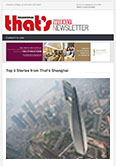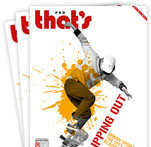While best-selling fantasy writer Lev Grossman has pulled out of this year's Lit Fest, organizers have capably rebounded with Andrew Field. The scholar has been a fixture in Shanghai, espousing its historical nightlife in books like the recently released Shanghai Nightscapes. We chat with the writer before his Nov 8 talk, with his co-writer James Farrer occasionally chiming in.
Congratulations on your new book Shanghai Nightscapes. How did this collaboration with James Farrer come about and is this book a continuation of your first book that explored Shanghai's dancing halls in the 1920s and 1930s?
James Farrer and I first met at a bar in Shanghai in 1996. He was finishing his dissertation on youth sexuality in Shanghai in the 1980s-90s, which became the topic of his book Opening Up. I was starting work on my dissertation, which became my first book Shanghai's Dancing World. Even then we discussed the idea of joining forces and creating a more comprehensive history of Shanghai through the lens of nightlife.
 JF: Andy and I did meet in a Shanghai bar in 1996, and I remember talking back then about working on a joint book. That makes this truly a very long collaboration. The most exciting and unique feature of this book is that it brings together contemporary fieldwork based on interviews and observations with historical research based on archives. To cover the period in the middle of the twentieth century we conducted oral history interviews with key figures in the Shanghai nightlife scene, both Chinese and foreigners.
JF: Andy and I did meet in a Shanghai bar in 1996, and I remember talking back then about working on a joint book. That makes this truly a very long collaboration. The most exciting and unique feature of this book is that it brings together contemporary fieldwork based on interviews and observations with historical research based on archives. To cover the period in the middle of the twentieth century we conducted oral history interviews with key figures in the Shanghai nightlife scene, both Chinese and foreigners.
In the process, though I am trained as a sociologist, I became a bit of a historian, investigating subjects as varied at Hattori Ryoichi, who put on jazz concerts in Shanghai as late as August 1945, and the popular culture of social dancing in Shanghai in the mid-1950s. Andy, who is a historian by training, delved into the arts of urban ethnography, writing about the contemporary nightlife scenes.
So this book turned out to be a very deep and thorough collaboration, as well as a long-term one. We visited many venues together, and we did quite a few interviews together. At the same time, I find we often brought a very different perspective to the study of nightlife, and the book is the result of many long nights of conversation and rewriting, as well as dozens of nights together out on the town. It has been a long, fun journey.
Shanghai's nightlife in the 1920s and 1930s are legendary. How well known was it at the time across China? Were there examples of people coming to the city to take part in this lifestyle?
Shanghai nightlife was legendary across China and around the world in the 1920s and '30s. Everybody who came to the city checked out its infamous nightclubs, ballrooms, and cabarets. These included famous actors and celebrities like Charles Chaplin, Douglas Fairbanks, Anna May Wong, and other Hollywood stars from the age.
Who were some of the colorful foreigner figures in the concession-era that you cover in this book that might interest our readers?
Whitey Smith was among the first jazz musicians who came from America to Shanghai in 1922. He later claims in his memoir I Didn't Make A Million that he 'taught China to dance' by incorporating Chinese elements into his music. His orchestra played at the Majestic, the Paramount, and many other famous ballrooms of the era.
There are many other colorful figures from that age as well, including Jack Riley, an ex-convict from America who ran the slot machines in Shanghai, and Joe Farren, an Austrian Jew who taught ballroom dancing with his wife Nellie, organized chorus lines at the Paramount, and later ran his own club Farrens. Farren died in the infamous Bridge House, the torture and detention center run by the Japanese military during WWII. Whitey escaped to Manila where he was incarcerated in a Japanese prison camp, and later went on to run a café in Manila with his Russian wife Helen, and died around 1970.
Then there's Teddy Weatherford, a black American stride pianist who came to China in 1926, played in Shanghai throughout the 1930s, and also traveled to India where he taught Indian musicians jazz. He died of cholera in 1945 in Calcutta, and is considered the godfather of jazz in India today. He also taught many other Asian musicians to play jazz including Japanese musicians.
But the most ubiquitous and hardworking jazz musicians in Shanghai back then were the Filipinos. No surprise that today Filipinos still dominate the live music club and bar scene in China and all over Asia.
The book resumes in the Reform Era. Do you have any insight on what sort of 'nightlife' activities may have occurred in Shanghai during the interim period?
In our book we describe interviews with musicians and dancers who danced and played during the Mao Years (1949-1976). At first this was allowed but after 1957, it became more dangerous to perform or dance to jazz music in Shanghai, so the music and dancing went 'underground' in the form of private house parties. Social dancing – with male and female partners – didn't reemerge as a public activity until after 1978.
JF: One additional example relates to the Japanese Jazz composer Hattori Ryoichi, who was active in Shanghai and wrote songs for Li Xianglan, including Suzhou Nights. Hattori went on to compose scores for Hong Kong movies after the war. Decades later his grandson, also a composer, Takayuki Hattori, became the music director for the Japan pavilion at the Shanghai Expo of 2010.
There are many cases of families in which memories and legacies of Shanghai nightlife and musical culture were handed down across generations. One of my favorite sections in our book is the story of the Shanghainese Qian family, who helped to keep alive the culture of ballroom dance in Shanghai across the twentieth century.
During the Reform Era, was Shanghai proud of its earlier reputation as a party city?
When dancing reemerged in the 1980s, it did so with a vengeance. By the late 1980s there were literally hundreds of social dancehalls operating in Shanghai by day and by night, catering to the city's working classes. Yet by the 1990s, as we describe in our book, young people became more attracted to disco clubs and bars, and social dancing aged out of the scene. By the 2000s most of the social dancehalls had shut down and social dancing became an outdoor activity dominated by late middle agers and elderly people, who dance in parks and other public places. This is a very charming aspect of the public parks and gardens that dot the city.
The book notes how important foreigners in the 1990s were in reestablishing Shanghai nightlife. Who were some of the important figures that opened up venues or organized events during this time?
In our book we discuss the importance especially of people from Hong Kong in reviving the nightlife scene in Shanghai. These were DJs, club owners and managers, not only Chinese but also Indians and Englishmen. We mention Andrew Bull, a Hong Kong-based British DJ who pioneered DJing for discos in Hong Kong since the 1970s, but the DJs who came here earliest and had the biggest impact were Vic Kishinch and and Ali Wong.
Today Vic runs an Indian restaurant on Changshu Road across from the Hilton Hotel. But foreigners or overseas Chinese weren't the only ones who galvanized the nightlife scene in Shanghai in the 1990s. Local players like Judy Qiu, owner of the famous Judy's clubs were also important.
And then there were people like Kenny Tang (also from Hong Kong) and Luke Chou (American Chinese) who started the D.D's club back in 1995. And in the bar and music scene there was Lin Dongfu, a famous Shanghainese actor, who started House of Blues and Jazz that same year. Matt Harding, an American guitarist who came here around that time, told me that he learned about the blues from Lin Dongfu. Later Matt went on to found the music program at Cotton Club. Soon after, Matt's friend Greg Smith took over. Greg is now a legend in the city's live music scene, and has played over 5,000 gigs in Shanghai.
 Watch the That's video of Greg Smith reflecting on 5,000 shows in Shanghai.
Watch the That's video of Greg Smith reflecting on 5,000 shows in Shanghai.
Are there any present-day trends that signify Shanghai's nightlife being different or unique from other international cities around the world?
I don't think that nightlife is unique anywhere in the world, to be honest. Urban nightlife is a global circuit of shared musical and dance cultures as well as design cultures. You won't find anything particularly unique about the nightlife of Shanghai or any city, other than the ways that the nightlife is embedded in the particular environment of the city.
In the case of Shanghai, the combination of the legacy of its semi-colonial 'concessions,' particularly the French Concession, and the super-futuristic skyscraper environment that has sprouted up since the late 1990s in Pudong and elsewhere create a fairly unique playground for nightlife to flourish.
In terms of dancing and drinking culture, Shanghai keeps up with the trends of other world cities. There are now speakeasies where you can get a specially crafted drink; go to Speak Low on Fuxing Road and order up an East of the Sun or a Smoke Gets in Your Eyes. Or you can go to MYST and order up a bucket of champagne bottles served with sparklers or flashing lights by the wait staff. Elegant and refined or over-the-top extravagant define the current parameters of Shanghai nightlife.
Personally speaking, what's your perfect night out in Shanghai's clubs?
As I've pretty much aged out of the clubbing scene, I tend to gravitate to bars featuring good drinks and/or live music. Going out with friends for a night on the town starting at a nice restaurant—there are so many of them it's impossible to name one in particular—followed by a visit to one of the live music clubs such as JZ Club for jazz or Yuyintang for rock, or to an artisanal drinking spot such as Speak Low for some unique cocktails is a good night.
But of course one also craves the random and unexpected encounters of a night on the town, so finding a new club or a newly hatching nightlife neighborhood that I didn't know existed is always fun too. Hard to do so when you've spent decades researching the night scene in Shanghai, but the city never fails to throw a few surprise punches now and then. One never knows what sort of adventure might ensue during a Shanghai night.
Last year, you wrote about Mu Shuying. Do you have any upcoming projects that you'd like to discuss?
I'm now writing a book on Chinese indie rock featuring SUBS and other bands that I filmed back in 2007. It's called Beijing Noise. It's nice to be focusing for a spell on the other Chinese city that I know and love.
> Nov 8, 1pm, RMB75. Glam, tickets.
> Shanghai Nightscapes available on Amazon.
> Check out our full preview of the Shanghai International Literary Festival and our festival related features.






















0 User Comments